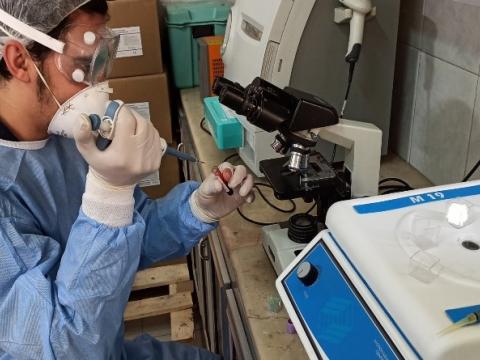COVID-19 crisis in Northwest Syria as positive tested cases triple in one month

A third COVID-19 wave has hit Northwest Syria hard. Only 1.3 per cent of the population in Northwest Syria has been vaccinated[1]; and daily testing positivity ranges between 53 per cent and 61 per cent since mid-September, in comparison with 6 per cent over the month of June[2]. Confirmed COVID-19 cases tripled in September as compared to July[3], even with the low capacity to carry out testing. Yet, as of today, testing has been completely suspended due to a lack of resources for people both inside and outside camps[4] even while intensive care unit beds in COVID-19 centres are at full occupancy. World Vision is calling on donors to urgently provide emergency funding for desperately needed COVID-19 health supplies and is ready to respond to the unfolding crisis.
As higher income countries return to normality, World Vision is gravely concerned by the escalating COVID-19 crisis in a country that has limited health care services. Only 13 oxygen concentrators are available across the region[5] and 97,000 testing kits were needed at the beginning of August but failed to materialise.[6]
“People are dying in Northwest Syria because they cannot access hospitals or public health facilities. They are either full or do not have the medical equipment required for COVID-19 treatment or other morbidities such as cancer. Even the facilities supported by World Vision are at 100 per cent occupancy rate,” says Johan Mooij, World Vision Syria Response Director.
The number of COVID-19 cases in Northwest Syria has been increasing rapidly since August, with an average of 1,750 positive cases per day between September 24-30 and was as high as 2,500 at the start of the month[7]. With testing on hold for an entire week, it will be impossible to accurately track the number of new positive cases and the death toll number will likely increase, especially in camps and congested locations. More than 13 per cent of those confirmed with COVID-19 live in camps[8].
“We were informed by one of our partners that two of their doctors died this week from COVID-19. With the worrying increase in cases amongst health personnel and a decimated health system, no one is safe until everyone is safe. It is also impossible to have a clear picture of how many people are affected by the virus due to limited lab capacity. Donors must urgently support aid organisations and health actors to scale up testing resources and life-saving equipment such as oxygen supplies,” adds Mooij.
Children living in fragile contexts such as this, with already weak or non-existent health services, or in crowded camps, struggle to survive as the pandemic overwhelms health systems and as a result of indirect health impacts, such as deadly diseases like malaria, lack of immunisation, or increased malnutrition.[9] Children too are exposed to the virus, and during the first five days of October, 131 girls and boys have already been diagnosed with COVID-19[10] in Northwest Syria.
Syria has only received only 30.2 percent11 of the required funding needed to respond to the immense needs in the country, while the number of people in need of humanitarian assistance has increased by 20 per cent in comparison with last year, reaching 13 million in 2021.
“The international community must act now before it is too late. Syria is battling a complex health crisis, conflict, a severe economic deterioration, an imminent risk of severe food insecurity and the one of the worst child protection crises witnessed so far,” comments Mooij.
Notes to editors:
World Vision has been delivering life-saving assistance and health, WASH, education, protection and livelihood support to over 1.2 million people inside Syria since the start of the crisis in 2011. On average, more than 75,000 beneficiaries benefit from World Vision’s Syria Response’s health supported services in the community, primary health-care facilities and hospitals. As part of its response to COVID-19 in Northwest Syria, World Vision is working in five COVID-19 dedicated facilities where we provide life-saving support by running intensive care units with equipment, and staffing as well as providing essential pharmaceutical supplies such as medications, consumables and oxygen. In addition, World Vision supports the epidemiological surveillance of COVID-19 by providing support to the PCR-laboratories, sample collection, transportation, analysis and result reporting, and contact tracing of cases, as well as the training of 1,500 volunteers, providing Information, Education and Communication materials and other support. World Vision’s Syria Response is also advocating for the equitable distribution of COVID-19 vaccines and recently participated in a research survey assessing national vaccine deployment readiness.
World Vision worldwide is responding to the devastating impact of COVID-19 in more than 70 countries, reaching more than 66.1 million people, including 28.9 million children.
For further information or to organise an interview, please contact Alexandra Matei at alexandra_matei@wvi.org, +962778482436
[1] WHO Health Cluster Bulletin 26 August 2021, Northwest Syria.
[2] Northwest Syria Health Cluster Dashboard, accessed 4 October 2021.
[3] Number of COVID-19 cases in July was 771 and 15 deaths, in August there was 12,839 cases with 55 deaths, in September the number of cases was 34,184 with 468 deaths.
[4] EWARN Northwest Syria field updates, 4 October 2021.
[5] Northwest Syria Health Cluster Dashboard, accessed 5 October 2021.
[6] Northwest Syria Health Cluster Dashboard, accessed 5 October 2021.
[7] Northwest Syria Health Cluster Dashboard, accessed 5 October 2021.
[8] Northwest Syria Health Cluster Dashboard, accessed 5 October 2021.
[9] WVI (2020f) COVID-19 aftershocks: Secondary impacts threaten more children’s live than disease itself. WVI, 7 April [Online]. Available from: https://www.wvi.org/publications/report/coronavirus-health-crisis/covid-19-aftershocks-secondary-impacts-threaten-more
[10] World Vision analysis based on WHO Health Cluster Dashboard, accessed 5 October 2021.